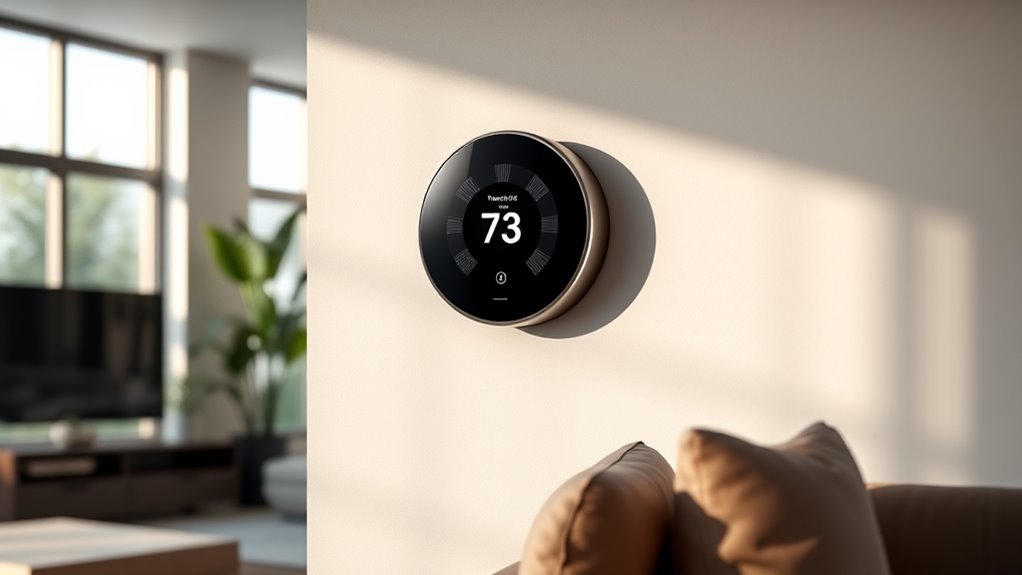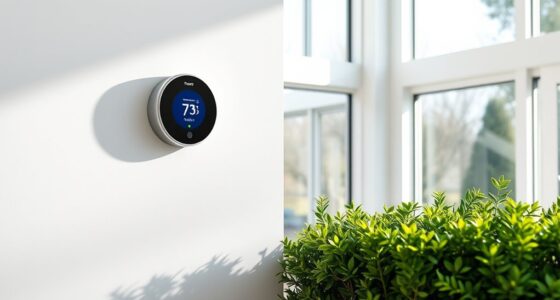If you’re looking for the best smart thermostats with proximity sensors, I recommend checking out models like ecobee’s SmartThermostat, Google Nest Learning Thermostat, and Sensi Touch, which all support occupancy detection and multi-room control. These devices help optimize comfort and save energy by adjusting settings based on presence. There are easy DIY options and compatibility with various HVAC systems. Continue exploring to find out which one fits your home and needs perfectly.
Key Takeaways
- Top models like ecobee SmartSensor and Honeywell T9 offer reliable proximity detection for personalized comfort.
- Compatibility with various HVAC systems and smart home platforms ensures versatile installation options.
- Features such as multi-room zone control and automatic HVAC adjustment optimize energy efficiency and comfort.
- Easy DIY setup with wireless or magnetic sensors allows flexible placement and minimal wiring.
- Integration with voice assistants and automation platforms enhances seamless control and smarter home management.
Mysa Smart Thermostat for Mini-Split Heat Pumps & AC

If you’re looking for a smart thermostat that’s easy to install and compatible with mini-split heat pumps and AC units, the Mysa Smart Thermostat is an excellent choice. It replaces your remote control with Wi-Fi programmability, making it simple to manage your climate from anywhere. The new wall mount design simplifies installation, while compatibility with HomeKit, Alexa, and Google Home means you can control it hands-free. The included remote and free app let you monitor and adjust your heating and cooling easily. Plus, its energy-saving features like schedules and geofencing help cut utility bills, and smart alerts keep your system safe and efficient.
Best For: homeowners seeking an easy-to-install, compatible smart thermostat to control mini-split heat pumps and AC units remotely and efficiently.
Pros:
- Easy to install with a new wall mount design and step-by-step video guidance
- Compatible with popular voice assistants like HomeKit, Alexa, and Google Home for hands-free control
- Offers energy-saving features such as schedules and geofencing to reduce utility bills
Cons:
- Requires Wi-Fi connection for remote access and full functionality
- May not be compatible with all types of HVAC systems outside mini-split heat pumps and AC units
- Advanced customization features are primarily accessible via the app, which may require a smartphone
Google Nest Learning Thermostat (4th Gen, 2024) with Nest Temperature Sensor
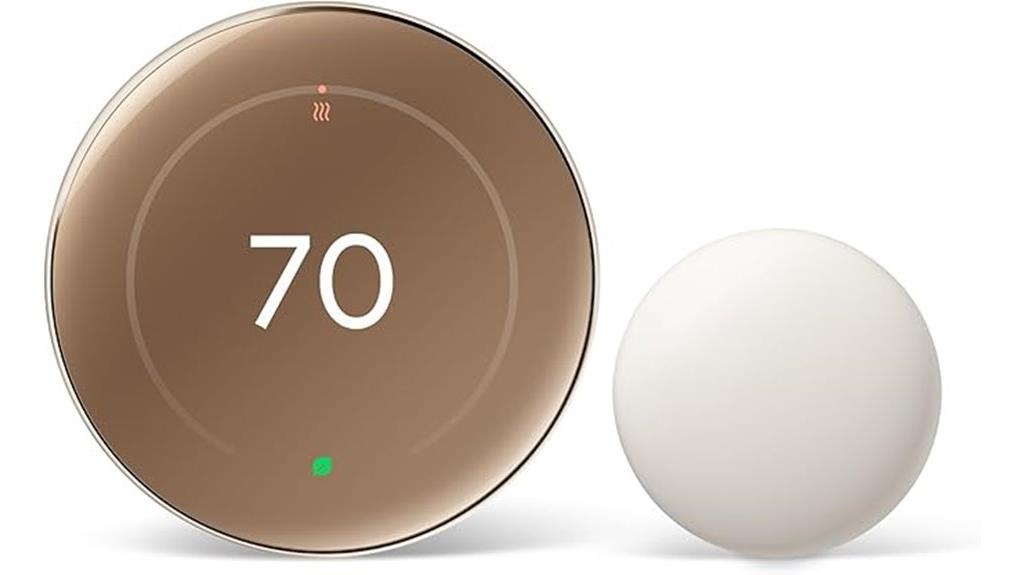
The Google Nest Learning Thermostat (4th Gen, 2024) with Nest Temperature Sensor stands out as an ideal choice for homeowners seeking a highly intelligent and adaptable heating and cooling solution. It works with most 24V systems, often without needing a C wire, and is Matter compatible for seamless smart home integration. The thermostat features a sleek design with a larger display and Dynamic Farsight, making it easy to read from across the room. Its self-learning capabilities optimize energy use based on your habits, while the Nest Temperature Sensors allow precise zone control. You can manage everything remotely via the app or with voice commands for maximum convenience.
Best For: homeowners seeking an intelligent, energy-efficient, and customizable smart thermostat that easily integrates with various HVAC systems and smart home devices.
Pros:
- Self-learning capabilities optimize heating and cooling schedules automatically.
- Large, attractive display with Dynamic Farsight for easy visibility from across the room.
- Compatible with most 24V systems and supports Matter for seamless smart home integration.
Cons:
- May require some setup adjustments for optimal zone control when using multiple sensors.
- Premium pricing compared to basic thermostats.
- Dependence on a stable internet connection for remote control and updates.
Sensi Touch 2 Smart Thermostat with Touchscreen

The Sensi Touch 2 Smart Thermostat with Touchscreen stands out for users who want an intuitive, modern interface combined with customizable scheduling and smart home integration. Its sleek LCD touchscreen makes navigation simple, while Wi-Fi connectivity allows remote control via the app or voice assistants like Alexa, Google Assistant, and SmartThings. Compatible with most HVAC systems, it supports room sensors for balanced, efficient comfort. The thermostat helps save about 23% on energy costs with flexible scheduling and maintenance alerts. Easy DIY installation, privacy protections, and positive reviews make it a reliable choice for modern homes seeking smarter comfort and energy savings.
Best For: homeowners seeking a sleek, easy-to-use smart thermostat with customizable scheduling and seamless smart home integration.
Pros:
- Intuitive LCD touchscreen interface for easy navigation and control
- Supports room sensors for balanced and efficient comfort across spaces
- Helps save approximately 23% on HVAC energy costs through flexible scheduling and remote monitoring
Cons:
- Limited temperature adjustment range for auxiliary heat and low-temperature settings
- Some users experience difficulty accessing outside temperature data on the thermostat
- Variability in technical support responsiveness and potential hardware concerns in relays
meross Smart WiFi Thermostat with Voice Control
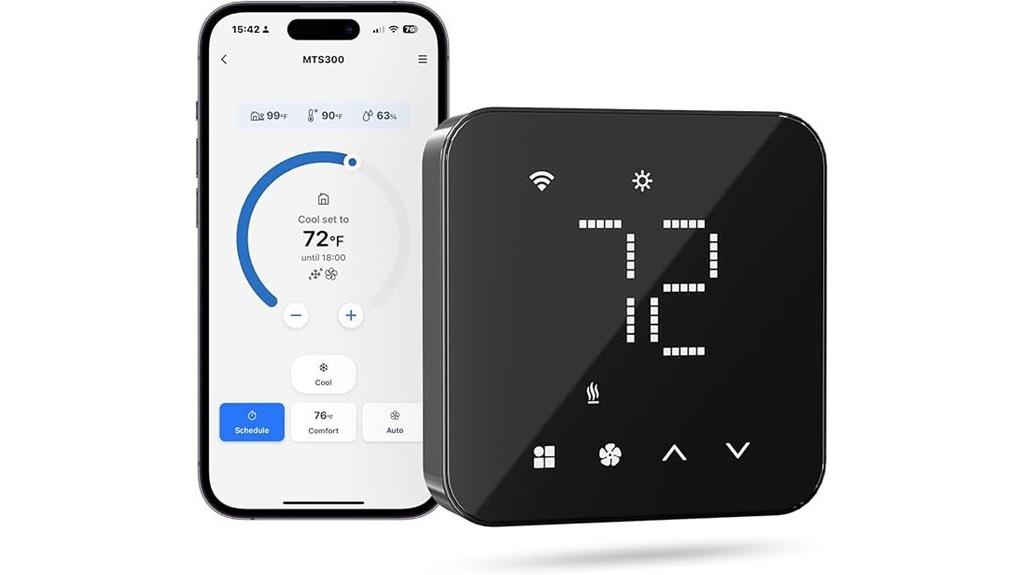
For homeowners seeking a reliable and easy-to-install smart thermostat, the meross Smart WiFi Thermostat with Voice Control stands out with its broad HVAC compatibility and straightforward setup process. It supports 95% of HVAC systems, including conventional heating and cooling, heat pumps, and heating-only or cooling-only units, though it’s not compatible with electric baseboard heaters. Setup is quick, usually taking about 30 minutes via the Meross app. It offers remote control through Wi-Fi, customizable schedules, and energy monitoring to save on bills. Plus, with Matter support, it seamlessly integrates with platforms like Alexa, Google Home, and Apple Home, and it responds to voice commands effortlessly.
Best For: homeowners seeking a versatile, easy-to-install smart thermostat compatible with most HVAC systems and seamless voice control integration.
Pros:
- Supports 95% of HVAC systems, including heat pumps and conventional units.
- Easy installation typically completed within 30 minutes using the Meross app.
- Offers remote control, customizable schedules, and energy monitoring for cost savings.
Cons:
- Not compatible with electric baseboard heaters.
- Requires a C-wire for proper operation; a C-wire adapter may be necessary if absent.
- Supports only 2.4GHz Wi-Fi networks, limiting compatibility with dual-band routers.
ecobee Smart Thermostat Premium with Sensors and Air Quality Monitor
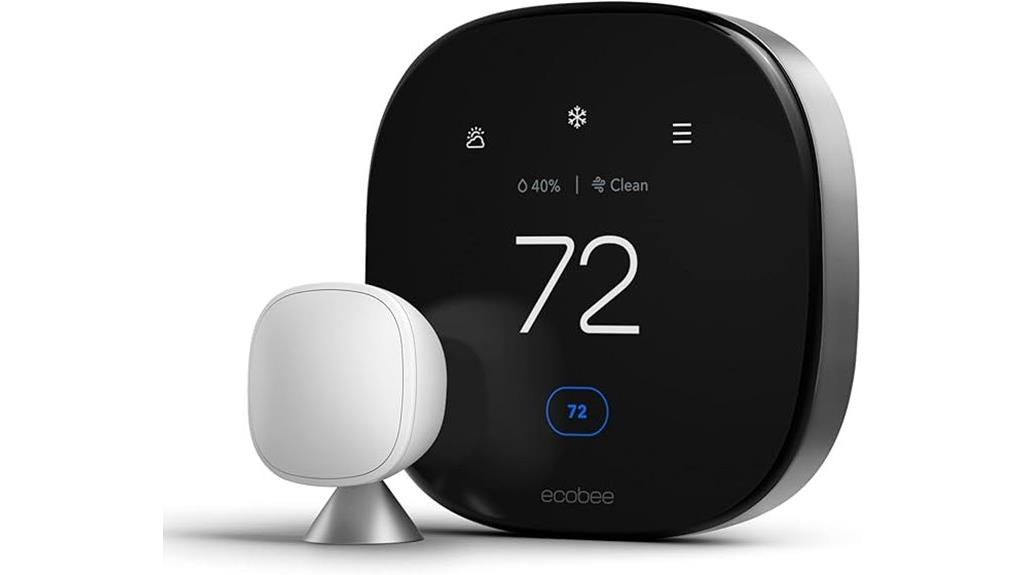
If you want a smart thermostat that combines energy savings with advanced air quality monitoring, the ecobee Smart Thermostat Premium with Sensors and Air Quality Monitor is a top choice. It can save you up to 26% annually on heating and cooling costs and is ENERGY STAR certified. The included SmartSensor adjusts temperatures in key rooms, reducing hot or cold spots. It also monitors air quality, alerts you to poor conditions, and reminds you to change filters. Plus, it detects sudden temperature drops and open windows or doors, pausing your HVAC to save energy. With its sleek design, voice control, and compatibility with most HVAC systems, it’s a smart way to upgrade your home comfort.
Best For: homeowners seeking to optimize energy savings while maintaining excellent air quality and modern smart home features.
Pros:
- Saves up to 26% annually on heating and cooling costs, providing significant energy savings.
- Built-in air quality monitor and SmartSensor for targeted comfort and health insights.
- Compatible with most 24VAC HVAC systems and integrates with voice assistants like Siri and Alexa.
Cons:
- Requires an Apple Home Hub for Siri voice control, adding an extra device for full functionality.
- Security features, such as home monitoring and alerts, need an additional Smart Security plan.
- Premium materials and advanced features may come at a higher price point compared to basic thermostats.
ecobee Smart Sensor 2 Pack for Smart Home Compatibility

Anyone looking to optimize comfort and security in their smart home should consider the ecobee Smart Sensor 2 Pack, especially since it seamlessly communicates with ecobee thermostats within 60 feet, even through walls. These sensors monitor room occupancy and temperature, allowing the thermostat to adjust settings for maximum comfort and energy savings. They can be placed magnetically or wall-mounted easily, ensuring accurate detection. Plus, they support security features like real-time motion alerts when Smart Security is active. By understanding household patterns and providing instant updates via the ecobee app, these sensors help create a smarter, safer, and more comfortable home environment.
Best For: homeowners seeking to enhance their smart home with reliable occupancy, temperature monitoring, and security integration compatible with ecobee thermostats.
Pros:
- Seamless communication within 60 ft through walls, ensuring reliable occupancy and temperature detection.
- Easy to install with magnetic placement or wall-mount options, providing flexible placement.
- Supports security alerts with real-time motion detection, enhancing home safety when paired with Smart Security.
Cons:
- Requires an ecobee Smart Security subscription for motion alert features.
- Limited to ecobee compatible thermostats and security systems, restricting broader smart home integration.
- Sensor placement effectiveness depends on correct positioning, which may require trial and error for optimal results.
ecobee Smart Thermostat Essential – Wi-Fi Programmable Thermostat

The ecobee Smart Thermostat Essential stands out as a cost-effective choice for homeowners seeking reliable energy savings and seamless smart home integration. It’s Energy Star certified and compatible with Siri, Alexa, Google Assistant, and Apple HomeKit, providing flexible control. With an intuitive LCD display and touchpad, it offers auto-scheduling, auto-away, fan control, and programmable settings. Designed for electric baseboard heaters, ACs, and furnaces, it efficiently manages heating and cooling. Installation is straightforward, especially for DIYers. Users typically save up to 23% on energy bills, with many reporting significant monthly savings that quickly offset its cost.
Best For: homeowners seeking an affordable, easy-to-install smart thermostat that offers energy savings and compatibility with popular voice assistants and smart home platforms.
Pros:
- Easy DIY installation with straightforward setup and user-friendly app controls
- Significant energy savings, potentially reducing bills by up to 23%
- Compatible with multiple smart home ecosystems including Siri, Alexa, Google Assistant, and Apple HomeKit
Cons:
- Limited scheduling flexibility, with only one schedule per season and 30-minute interval adjustments
- Requires a C wire for power, which may need additional wiring or workarounds for some setups
- Basic features lack advanced customization options, which may frustrate users seeking more control
Honeywell Home T9 WiFi Smart Thermostat

The Honeywell Home T9 WiFi Smart Thermostat stands out for its multi-room control capabilities, making it an excellent choice for homeowners seeking personalized comfort and energy efficiency across different spaces. With its touchscreen display, built-in speaker, and compatibility with popular voice assistants, it offers flexible control options. The thermostat works with Honeywell’s Smart Room Sensors, allowing you to monitor temperature and humidity in multiple rooms and create balanced comfort. Installation is straightforward, even without a C-wire, and the app simplifies setup and adjustments. While it’s pricier and has some connectivity quirks, the T9’s multi-room focus and energy-saving features make it a top-tier smart thermostat.
Best For: homeowners seeking customizable multi-room climate control and energy savings with flexible voice and app management.
Pros:
- Supports multi-room control with Honeywell Smart Room Sensors for personalized comfort.
- Easy DIY installation, even in homes without a C-wire, with straightforward app setup.
- Compatible with multiple voice assistants like Alexa, Google Assistant, and Apple HomeKit for convenient control.
Cons:
- Higher price point over $300, especially with additional sensors.
- Limited instructions and support for sensor installation, which may require extra effort.
- Occasional Wi-Fi connectivity issues, particularly with 5GHz networks, can affect performance.
ecobee Smart Thermostat Enhanced, Wi-Fi Programmable Thermostat

If you’re looking to optimize both comfort and energy savings, the ecobee Smart Thermostat Enhanced is an excellent choice, especially for those who want precise control over their home’s temperature. It can save up to 26% annually on heating and cooling costs by automatically adjusting when you’re away and preconditioning your home before you arrive. With SmartSensor technology, it monitors room-specific temperatures, focusing on key areas for consistent comfort. Compatible with Siri, Alexa, Google Assistant, and most smart home platforms, you can control it remotely via the ecobee app or voice commands. Its easy installation and Energy Star certification make it a reliable, energy-efficient upgrade for any smart home.
Best For: homeowners seeking a smart, energy-efficient thermostat with precise room control and seamless smart home integration.
Pros:
- Saves up to 26% annually on energy costs through automatic adjustments and preconditioning.
- Compatible with major voice assistants like Siri, Alexa, and Google Assistant for easy control.
- Easy to install with a Power Extender Kit and suitable for most HVAC systems, including those without a C-Wire.
Cons:
- May require additional setup or professional installation for complex HVAC systems.
- Some users might find the smart features and app controls unnecessary if they prefer manual adjustments.
- The initial cost can be higher compared to basic thermostats, though savings offset this over time.
Google Nest Learning Thermostat (4th Gen, 2024) with Temperature Sensor
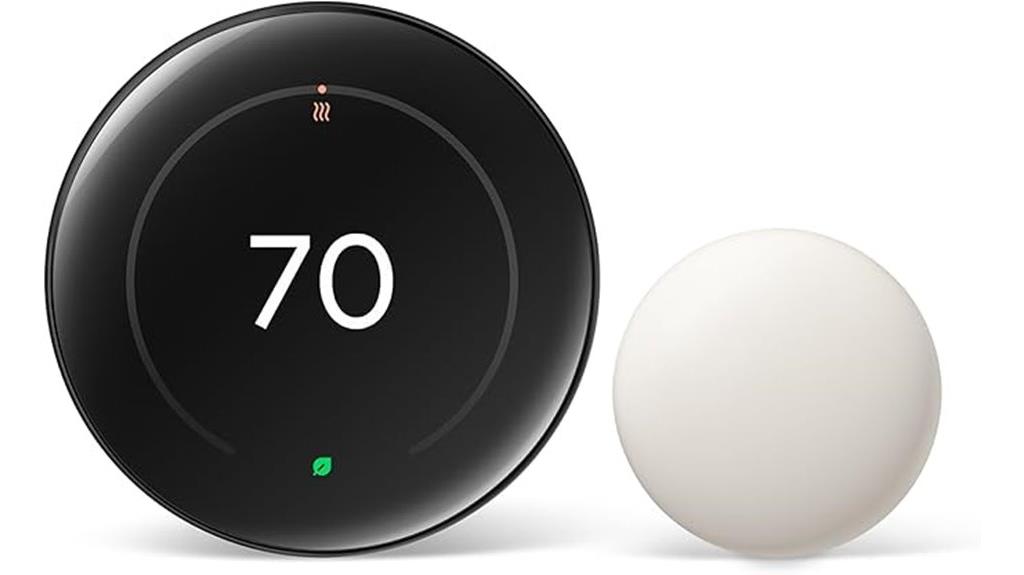
Anyone looking for a smart thermostat that seamlessly combines advanced learning capabilities with precise temperature management will find the Google Nest Learning Thermostat (4th Gen, 2024) with Temperature Sensor to be an excellent choice. Its sleek Obsidian finish and larger display with Dynamic Farsight make it both stylish and easy to read from across the room. It’s compatible with most 24V systems and integrates smoothly with Alexa, Apple HomeKit, and Google Assistant. The thermostat learns your habits, suggests schedule adjustments, and works with Nest Temperature Sensors to manage hot and cold spots. Plus, remote control via the Google Home app makes home comfort effortless and energy-efficient.
Best For: homeowners seeking an intelligent, easy-to-use smart thermostat that offers energy savings, seamless integration, and customizable comfort control.
Pros:
- Advanced learning capabilities that adapt to user habits for optimal comfort and savings
- Compatible with major smart home ecosystems including Alexa, Apple HomeKit, and Google Assistant
- Larger display with Dynamic Farsight enhances visibility from across the room
Cons:
- May require a C wire for certain installation setups, which could involve additional wiring work
- Premium price point compared to basic thermostats
- Reliance on Wi-Fi connectivity means offline functionality is limited
Invita Wi-Fi Thermostat, Energy Star Approved, 2-Stage/4-Stage Heat & Cool
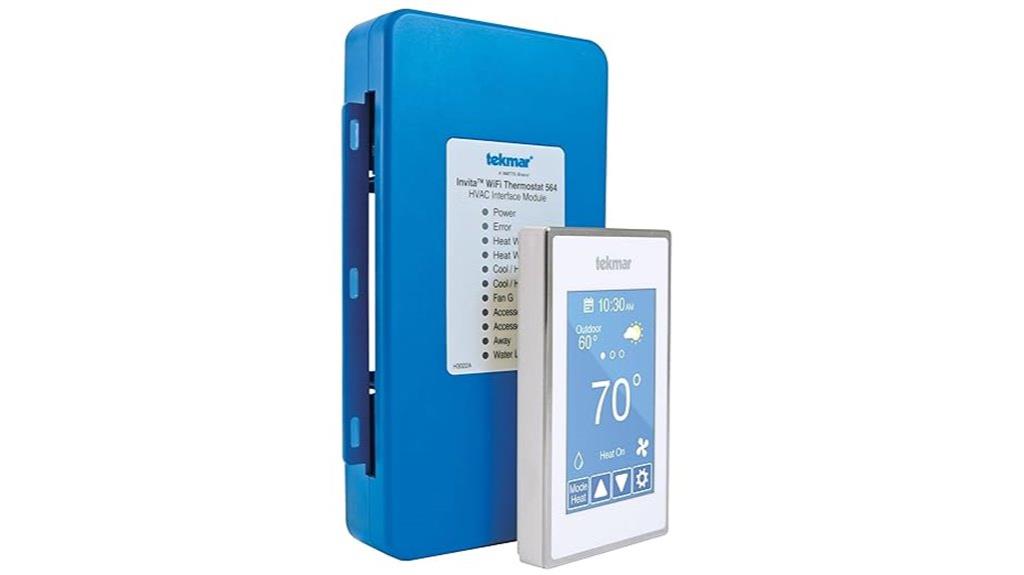
For homeowners seeking a reliable, energy-efficient thermostat compatible with various HVAC systems, the Invita Wi-Fi Thermostat stands out with its Energy Star approval and support for 2-stage or 4-stage heat and cool. It’s easy to install, connecting via existing wires without complicated rewiring. Compatible with conventional systems, heat pumps, and dual fuel setups, it offers full control over temperature, humidity, and ventilation. The high-resolution touchscreen, remote app management, and voice control through Alexa and Google Home make daily adjustments simple. While installation takes under an hour, its advanced features and sleek design provide an excellent balance of smart control and user-friendly operation.
Best For: homeowners seeking a high-end, customizable, and energy-efficient Wi-Fi thermostat compatible with various HVAC systems and easy to install.
Pros:
- Supports up to 2-stage or 4-stage heat and cool, offering flexible climate control.
- Energy Star approved, ensuring energy savings and environmental friendliness.
- Remote management via smartphone app and voice control with Alexa and Google Home for convenience.
Cons:
- Higher price point around $350, which may be steep for some buyers.
- Installation, while straightforward, is more involved than plug-and-play models like Nest.
- Occasional Wi-Fi connectivity issues reported, potentially affecting remote control reliability.
Sensi Lite Smart Thermostat

The Sensi Lite Smart Thermostat by Emerson stands out as an ideal choice for homeowners seeking an easy-to-install, energy-efficient device that offers reliable remote control. It’s Energy Star certified, supports most HVAC systems, and doesn’t require a C-wire for many setups. The sleek LCD display and app control via Wi-Fi make managing your home’s temperature simple and convenient. Compatible with Alexa, Google Assistant, and SmartThings, it features programmable schedules, auto changeover, and a filter indicator. Setup is straightforward with step-by-step instructions, and its compact design fits seamlessly into most homes. Overall, it’s a cost-effective, user-friendly thermostat that helps save energy effortlessly.
Best For: homeowners seeking an easy-to-install, energy-efficient smart thermostat compatible with most HVAC systems and without the need for complex wiring.
Pros:
- Simple DIY installation with clear instructions and minimal wiring required
- Energy Star certified, helping to save approximately 23% on HVAC energy costs
- Compatible with popular voice assistants like Alexa, Google Assistant, and SmartThings
Cons:
- Wi-Fi connectivity issues reported after power outages or battery replacements
- Limited scheduling flexibility and app statistics compared to higher-end models
- Not recommended for use outside US/Canada and may require additional wiring considerations for heat pumps or zone systems
ecobee Smart Thermostat Premium 2-Pack
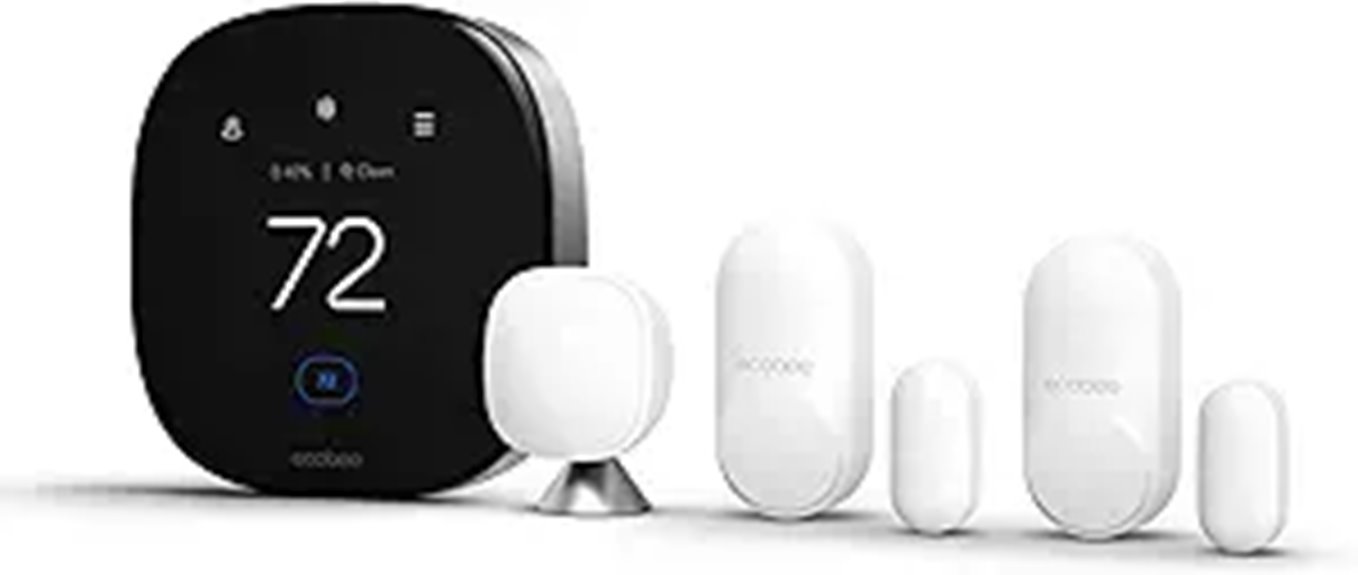
If you’re looking to maximize energy savings while maintaining ideal comfort, the ecobee Smart Thermostat Premium 2-Pack is an excellent choice. It can save up to 26% annually on heating and cooling costs and is ENERGY STAR certified. The package includes a SmartSensor for doors and windows, helping to reduce hot and cold spots for consistent comfort. It also monitors air quality and reminds you to change filters, while built-in contact sensors secure doors and windows, providing alerts for entry or motion. Compatible with Siri and Alexa, this 2-pack is perfect for controlling multiple rooms efficiently and intelligently.
Best For: homeowners seeking to optimize energy efficiency and comfort across multiple rooms with smart, integrated monitoring and security features.
Pros:
- Up to 26% annual savings on heating and cooling costs.
- ENERGY STAR certified for energy efficiency.
- Includes SmartSensor for enhanced comfort and air quality monitoring.
Cons:
- Requires a separate ecobee Smart Security subscription for contact sensors.
- May be more expensive upfront compared to basic thermostats.
- Compatibility with voice assistants depends on existing smart home setup.
Google Nest Thermostat, Programmable Wi-Fi Thermostat
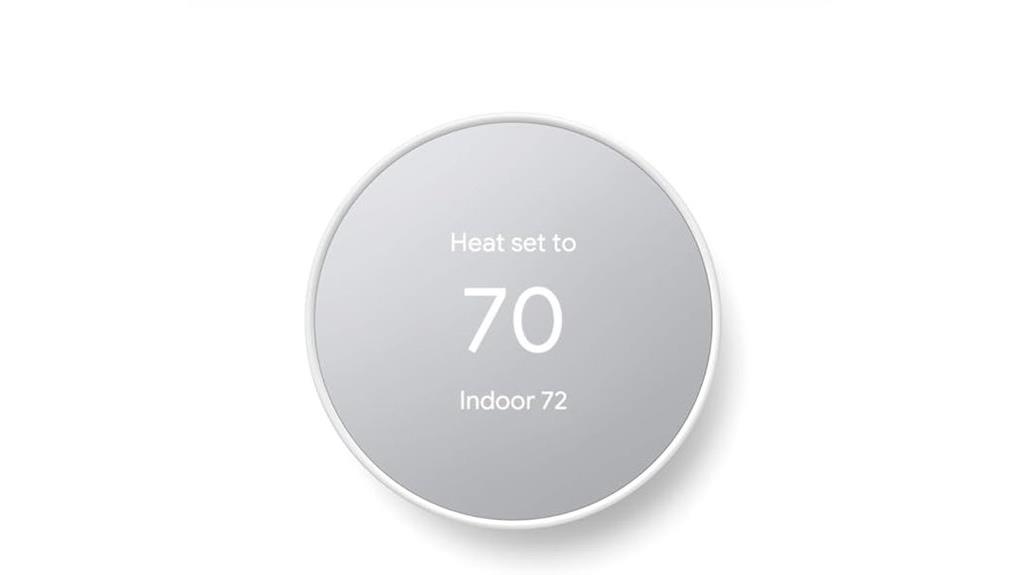
Looking for a sleek, energy-efficient thermostat that seamlessly integrates with your smart home setup? The Google Nest Thermostat is a stylish, programmable Wi-Fi device designed to enhance home comfort and save energy. It supports various HVAC systems, including heat pumps, and is ENERGY STAR certified. With its easy DIY installation, intuitive interface, and remote control via the Google Home app, you can adjust temperatures anytime, anywhere. Voice control with Google Assistant or Alexa adds convenience, while features like system health monitoring and energy-saving suggestions help reduce costs. Its modern design blends well with home decor, making it a smart upgrade for any connected home.
Best For: homeowners seeking a sleek, energy-efficient, and easily installable smart thermostat that integrates seamlessly with their existing smart home ecosystem.
Pros:
- Supports multiple HVAC systems including heat pumps, with ENERGY STAR certification for energy savings.
- Easy DIY installation typically completed in 30 minutes with intuitive user interface.
- Remote control and voice integration via Google Assistant, Alexa, iOS, and Android for convenient temperature management.
Cons:
- Initial setup can be challenging, especially with wiring and system compatibility issues.
- Offline functionality is limited, which may cause problems during internet outages.
- Some users report accuracy concerns at low humidity levels and require online support for troubleshooting.
Amazon Smart Thermostat
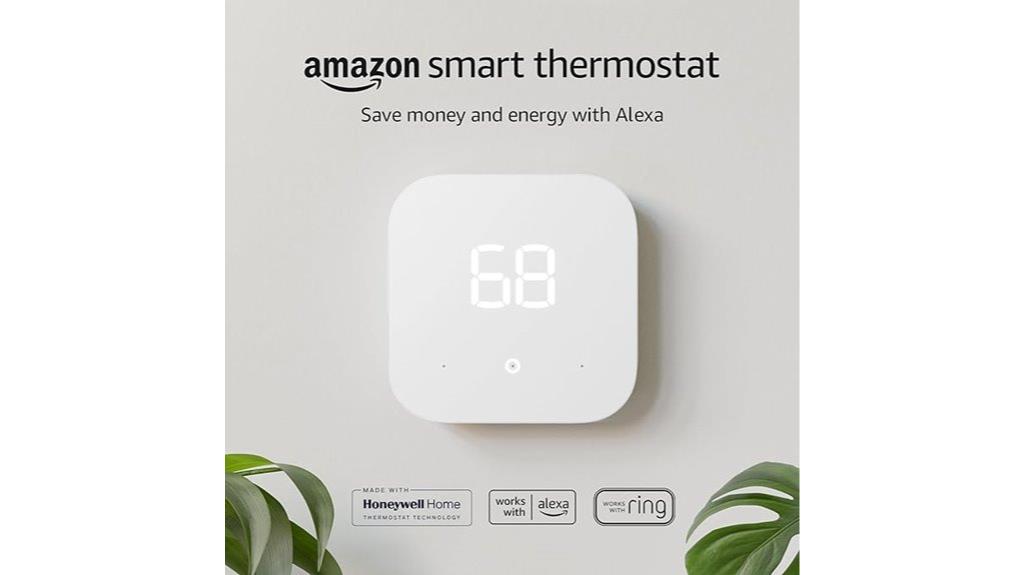
For those seeking an easy upgrade to a smart thermostat, the Amazon Smart Thermostat stands out with its seamless Alexa integration and support for C-wire installation. It’s compatible with Echo devices like the Echo Dot (4th and 5th gen) and Ring products, making voice control simple. This thermostat helps cut energy costs—EPA estimates suggest savings of around $50 annually—and Amazon even provides info on rebates to lower expenses further. Installation is straightforward thanks to guided setup via the Alexa app, and customer support is readily available. Built with trusted Honeywell technology, it promises durability, reliability, and smarter home comfort with minimal effort.
Best For: homeowners seeking an easy-to-install, smart thermostat that seamlessly integrates with Alexa and helps reduce energy costs.
Pros:
- Easy upgrade with guided installation via the Alexa app
- Compatible with popular Echo devices and Ring products for voice control
- Supports energy savings of approximately $50 annually, with rebate assistance from Amazon
Cons:
- Requires a C-wire for installation, which may not be available in all homes
- Limited compatibility with certain older HVAC systems
- Dependence on Wi-Fi and app connectivity for full functionality
Factors to Consider When Choosing a Smart Thermostat With Proximity Sensors

When choosing a smart thermostat with proximity sensors, I consider several key factors to guarantee it fits my needs. Things like sensor placement flexibility, compatibility with my HVAC system, and how easy it is to install really matter to me. I also look for energy-saving features and how well it integrates with my smart home platforms.
Sensor Placement Flexibility
Flexible sensor placement is crucial because it allows you to customize the coverage of your smart thermostat to suit your home’s layout. With adjustable placement options, you can optimize comfort and energy efficiency across multiple rooms. Wireless or magnetic sensors make positioning easy without extensive wiring, giving you freedom to place them where they’re most effective. Placing sensors at least 5 feet above the floor ensures accurate occupancy detection and temperature readings. Additionally, adjustable locations help prevent false readings caused by pets, drafts, or obstructions. Some thermostats even support multiple sensors in different zones, offering granular control over heating and cooling. Overall, flexible sensor placement enhances your ability to tailor your smart thermostat’s performance to your unique home environment.
Compatibility With HVAC Systems
Choosing the right smart thermostat with proximity sensors depends heavily on its compatibility with your HVAC system. First, make sure it supports your specific setup, whether it’s a heat pump, boiler, or dual fuel system, to guarantee proper operation. Many models require a 24V control system and a C-wire for consistent power, so check if your system has these features. Proximity sensors communicate via protocols like Zigbee, Z-Wave, or Wi-Fi, so verifying compatibility is vital for seamless integration. Also, review the thermostat’s supported brands and models to avoid installation issues or limited performance. Keep in mind that some proximity-enabled thermostats might not work with high-voltage systems like electric baseboards, which could restrict your options. Compatibility is key to a smooth, efficient smart home setup.
Ease of Installation
Installing a smart thermostat with proximity sensors can be straightforward, especially if you select a model designed for DIY setup. Many models require only basic tools and minimal wiring knowledge, making installation accessible for most homeowners. The process usually involves connecting existing HVAC wires and mounting the device on the wall, with some models offering step-by-step video guides to simplify the task. Compatibility with your home’s wiring, particularly the presence of a C-wire, can impact how easy the setup is. Additionally, some thermostats feature wireless or magnetic sensors that don’t require complex wiring, further easing installation. Certain models also include virtual emulators or detailed setup guides, helping troubleshoot issues without professional help. Overall, choosing a user-friendly design can make setup quick and hassle-free.
Energy Saving Features
Proximity sensors in smart thermostats can considerably reduce energy consumption by automatically adjusting settings based on your presence. When you leave a room, these sensors detect your absence and lower heating or cooling, preventing wasted energy. They also enable automatic “away” modes that turn off or reduce system activity when no one is nearby, which can cut energy use by up to 26% annually. By integrating with scheduling and geofencing, proximity sensors adapt to your habits, ensuring your home stays comfortable while minimizing unnecessary energy expenditure. Additionally, they improve zone control, reducing temperature fluctuations and maintaining comfort efficiently. Overall, these features help you save money and energy without sacrificing convenience, making proximity sensors a valuable factor when choosing a smart thermostat.
Integration With Smart Platforms
To make the most of your smart thermostat’s proximity sensors, it’s essential to guarantee it seamlessly integrates with your existing smart home platforms. Support for popular systems like Alexa, Google Assistant, Apple HomeKit, or SmartThings ensures smooth voice control and automation. Confirm that the thermostat is Matter-compatible, allowing it to work effortlessly across various ecosystems and devices. A dedicated app that integrates with your smart home setup enables remote control and monitoring, adding convenience. Multi-platform voice control support lets you command your thermostat through different assistants like Alexa, Siri, or Google Assistant, enhancing flexibility. Additionally, compatibility with smart sensors and other devices can further automate your home, optimizing comfort and energy efficiency. Proper integration is key to a truly smart and cohesive home experience.
Privacy and Data Security
Since smart thermostats with proximity sensors gather data on your presence and movements, it’s crucial to take into account how this information is protected. These devices collect sensitive data, so it’s important to check how it’s stored, shared, and secured. Many use encryption protocols for data transmission and storage, but vulnerabilities can still occur if security practices aren’t up to date. I recommend reviewing privacy policies to see if your data might be shared with third parties or used for targeted ads. Some thermostats offer local control options that don’t rely on cloud storage, reducing privacy risks. Also, regularly updating firmware and security patches is essential to keep your proximity data safe from breaches and unauthorized access.
Frequently Asked Questions
How Do Proximity Sensors Improve Smart Thermostat Energy Efficiency?
Proximity sensors make smart thermostats more energy-efficient by detecting when I’m near or away. When I approach, the thermostat automatically adjusts to my preferred temperature, ensuring comfort without wasting energy. When I leave, it senses my absence and lowers the heat or cooling to save power. This smart feature eliminates manual adjustments, helping me cut energy costs while maintaining a cozy home environment.
Are Proximity Sensors Compatible With All HVAC Systems?
Proximity sensors aren’t compatible with all HVAC systems, so I always recommend checking the thermostat’s specifications first. They work best with modern, smart-enabled systems that support integration. If your system is older or more basic, the sensor might not function properly or could require additional adapters. I suggest consulting a professional to verify compatibility and peak performance, so you get the most out of your smart home upgrades.
Can Proximity Sensors Detect Multiple Users Simultaneously?
You’re wondering if proximity sensors can detect multiple users at once. I’ve found that most smart thermostats with proximity sensors are designed to recognize individual presence, but they often struggle to differentiate multiple users simultaneously. Some advanced models may identify multiple people, but accuracy can vary. So, while they can sometimes detect more than one person, relying on them for precise multi-user detection isn’t always foolproof.
Do Proximity Sensors Work Effectively in Large or Multi-Story Homes?
Proximity sensors can work well in large or multi-story homes, but their effectiveness depends on the sensor type and placement. I’ve found that sensors with wider detection ranges or multiple sensors strategically placed help guarantee accurate user detection across different areas. It’s important to choose a system designed for larger spaces, as some sensors might struggle with signal strength or obstructions, but proper setup can greatly improve performance.
How Secure Are Proximity Sensor Data and User Privacy?
Imagine your home’s data as a delicate butterfly, fluttering softly through the digital garden. I believe proximity sensor data and user privacy are quite secure when manufacturers use robust encryption and strict data policies. Still, I stay vigilant, regularly updating firmware and choosing brands that prioritize privacy. Trustworthy companies treat your data like precious treasure, making sure it stays locked tight and out of reach from prying eyes.
Conclusion
Choosing the right smart thermostat with proximity sensors can truly transform your home comfort. With options like the ecobee Premium or the Google Nest Learning Thermostat, you’ll enjoy energy savings and personalized control. So, why settle for less when you can have a smarter, more responsive home? Isn’t it time to upgrade and experience the convenience of a thermostat that learns and adapts to your lifestyle? Your perfect comfort solution is just a decision away.
